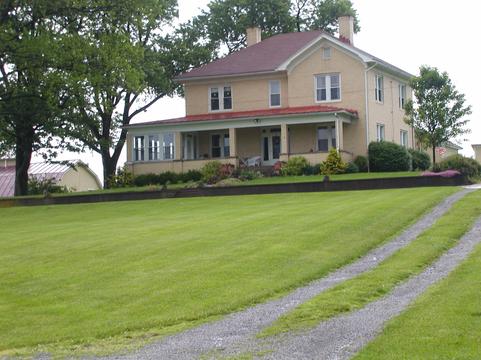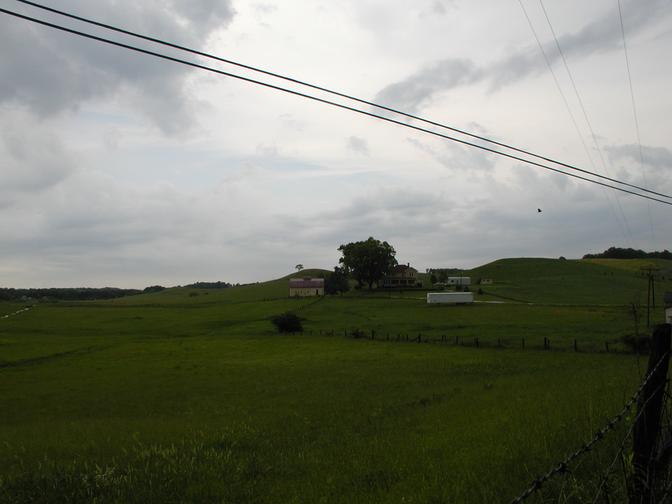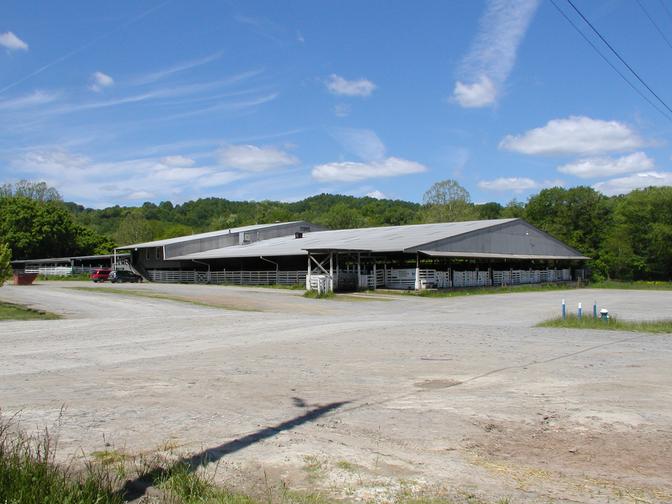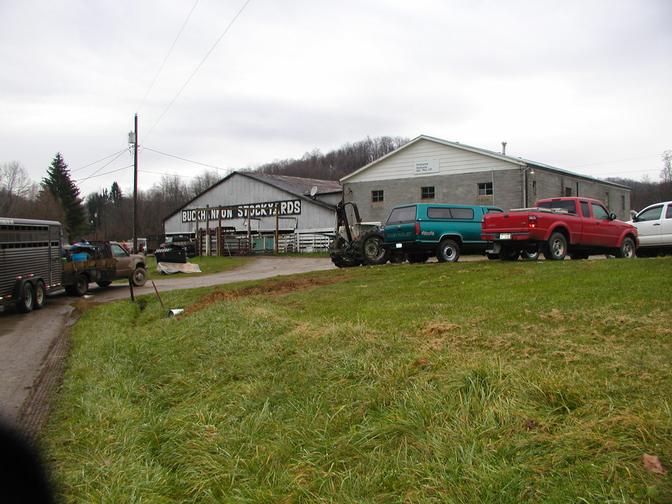
| Next Chapter | Previous Chapter | |
| Chapter 55: Farming Schemes - Changes with Time | Contents | Chapter 53: Borrowed Money |
At the time of my first memory of the sale at Weston it was owned by Charlie Morrow and French Trimble. Mr. Morrow owned a magnificent farm east of Bridgeport, about half way to Pruntytown. The large yellow brick house, built in the style common around the time of WWI, still stands in its fields much as it did then. It was a great place to farm, with gently rolling fields and white board fences reminiscent of some places in California. The development people are closing in on it, now, though. The land is too level and too near Bridgeport to be left alone, apparently.
The place of sale was referred to as “Deanville” in my youth, and it was not much different from the arrangement we have there in 2001, although it has been completely rebuilt.
(Illustrations 54-1)

Residence on the “Charlie Morrow Place”
The sale is now owned by C. D. Cole. There are places for trucks to back into the loading docks, which are straight down at the end of Louisa Street,on the left side. There are scales, pens, a sale ring, and a restaurant. When I was a child it was mostly built of wood, except for the galvanized roof. Now there is much metal in the superstructure. Litter was then removed by shovel and wheelbarrow and now is removed by shovel and a small skid-steer loader. One new thing is a provision to unload the low
(illustraton 54-2)

Fine land on the “Charlie Morrow Place”
cattle trailers pulled behind small trucks. Since the trailers are so low, loading docks can’t be used. They have two sets of gates so you can drive through an alley leading to the pens. You drive through both gates, close the one on the back side of the alley, and fit the ones on the front side next to your trailer so the animals can not escape while unloading. C. D. Cole also does a lot of cattle trading outside the sale, owns the butcher shop adjacent to the sale, provides trucking, and maintains several farms to keep cattle he buys to increase their value.
There has been a tremendous change in the body conformation of beef animal in my lifetime. Fifty years ago beef animals were expected to have short legs, be short from front to rear and wide as possible, with a perfectly smooth exterior. It was made smooth by exterior fat. A lot of attention was placed on having a tail set smoothly into the body, rather than raised above it. The rationale was that excess leg was waste, and you wanted thick cuts in the quarters.
Then someone did research which found out that this preferred body conformation was exactly the most uneconomic way to produce beef. It meant the animal gained weight slowly and took more food to grow. This has always been a weak point of grain fed beef. At that time eight pounds of grain were required to produce a pound of beef, versus two and one half to three pounds of grain to produce a pound of chicken and five for a pound of hog. At present five pounds of grain will produce a pound of beef and one and one half pounds of grain will produce a pound of chicken. Of course, if you want to do it with less grain, some of the weight of a beef animal is put on with grass, before the grain finishing occurs.
About twenty-five years ago we went through a period of ideal body type being the exact opposite of the body type desired in my youth. They thought a beef should be tall, not wide, and very long. If you look at pictures from fifty years ago you will see fat, blocky animals standing in straw up to their bellies – to hide the fact they have any legs at all. Later cattle are tall, long, well muscled, not fat, and invariably have their picture taken from low angle with no straw underneath to emphasize the length of the legs. . Now we are in a period of some moderation, looking at a lot of traits in addition to body shape.
We now can look at individual muscles with ultrasound, the same device doctors use to look at a human fetus. Of particular interest is the loin eye, the muscle parallel to the back bone which gives the filet mignon. Other cuts of this muscle will also result in expensive meat cuts. Also, it is possible to assess the chance a heifer will have trouble having a calf by measuring the bones in her pelvis.
The most important characteristic of cattle always has been health. The most objectionable body type fifty years ago was to have a beef animal mixed with a milk animal. Milk animals are rare now in this area, so that particular problem has almost disappeared. All that is objectionable is the bad breeding of the past, left over on some farms. Some people keep cheap animals, rather than good ones. And animals that have not been handled properly are a problem. Injections in muscle, rather than under the skin, damage the meat, as do bruises, puncture wounds, and such.
The methods used to handle cattle and the other animals are more humane than they once were. When I was a child the handlers used hickory sticks about 4 feet long. When I was a kid there was a man at the sale who sold canes, waist high with a curved handle, made of hickory shoots. Some farmers, mostly older ones, used them. Now handlers use a white fiberglass rod, about the same length, with a leather thong at the end that makes a cracking sound, or that they can touch the animals with. Cattle hate to be touched. Some handlers use “rattle paddles,” which have a three foot handle, and on the end of that, a hollow plastic paddle four or five inches wide and eighteen inches long with balls on the inside which rattle. You still see some gratuitous infliction of pain, but not much. Many of the animals are large, and a few are really dangerous because of the unfamiliar confusion. Some are just mean. The handlers must be very careful. I have seen more than one person knocked flat, and there is potential for very serious injury or death. Electric prods are used on farms and by truckers, but seldom in the sales.
When I was a kid, animals were put in similar lots or sold individually pretty much without any special skill. There was one kind of sale – the weekly sale with all kinds of livestock. They began special feeder calf “demonstration” sales at Jackson’s Mill at that time. These were sales where calves born to cows bred by quality purebred bulls were sold in lots graded as to size and breed and “grade.” Grade is mostly a matter of how the animal will mature: short blocky animals mature relatively soon and
(Illustration 54-3)

The sale barn at Weston as it appears today. At the nearest point is the provision for unloading “gooseneck” trailers pulled behind farmer’s pickups.
at light weights, and the longer and taller the animal is, the longer it takes to reach maturity (the proper amount of fat to butcher) and the heavier it will be. Buyers from the Midwest or Pennsylvania don’t want to buy calves one at a time when they are looking for trailer loads of them, but they want to buy similar animals, to mature at the same time, so the sorting is necessary to get the best price.
One of the biggest changes at the sale is the number of women working the animals. It is dangerous and so was considered inappropriate for women when I was a kid. Women kept the records in the office, wrote checks, etc, and were sometimes employed to operate the scales. But they weren’t found in the alleyways and sale ring. There are still far more men than women in that dangerous occupation, but you see some at most sales now. The clerical work is still almost exclusively done by women.
There are a lot more women in the stands at the sales, too, and a lot more kids, including girls. In some cases they are watching an important economic event for the family, but in most cases they are just enjoying no-cost entertainment. A lot of visiting goes on in the stands for both men and women. Women of higher social status simply do not go to the weekly cattle sales, but they do go to purebred sales and the Jackson’s Mill sales. A female former member of the House of Delegates, Marge Burk, is often seen at these special sales, and even helps work the cattle.
Today it costs fourteen to twenty dollars to sell an animal through the ring. This is about 2 to 4 percent of the sale price. Included is about fifty cents for insurance, a dollar for the “checkoff,” a government sponsored advertising scheme, and the commission for the sale costs and profit to motivate the sale owner.
There is also a sale at Buckhannon which is quite successful. It is run by Sam Garrett and his father-in law, Virgil Helmick. Sam also does a lot of cattle trading outside the sale, and trades furs, batteries, ginseng and various other things. There once was a sale at Bridgeport, where I bought cattle in my younger years, but it was in the city, right on the principal crossroads, and the city got rid of it. So much the better for Weston and Buckhannon, or at least, the people who owned the sales there.
Illustration 54-4)

The sale at Buckhannon on a December day in 2006
One of the things the reader who is trying to grasp changes with time should recognize is that the number of cattle produced by West Virginia is about constant from the time the forest was pushed back to its greatest extent, perhaps in the 20’s or 30’s, until the present. The reason for this is not clear to me. Certainly methods are better, over grazing like I saw practiced routinely as a youth is a rarity, and this increases grass production. Lime and fertilizer are used more, on most farms, but not a lot. Retreat to the best land is part of it. Corn is a rarity now, erosion is much reduced, the forest has returned to over 90 percent of the land. But how do the cattle numbers stay up with so much forest?
Aside The institution of slavery was almost universal in distant times past. Africa, Europe, even some American Indian tribes had slaves. Great Britain abolished slavery at home in 1808 and in the Empire in 1833, and elimination of slavery in the U. S. was one result of the Civil War. I became a teenager in 1947. By that time the older people could still remember old people in their youth who had direct knowledge of that great war, and slave times. No one talked about it. Only two more or less complete stories have been told to me about slavery, the first by Rennie Reinhart.
The farm above ours on Jesse Run was put together by a Cookman, who came up from Old Virginia to the Virginia frontier in 1845 with five black families. Cookman carried pear, apple and cherry trees in his saddlebags. They built a log house for the Cookman family and log cabins for the slave families close behind it up what is now called Clay Lick . Then they went to work clearing the land, somewhat less than 300 acres.
The farm prospered and shortly after the present farmhouse was built, the first Civil War Troops marched up Jesse Run. The house was built by a Pennsylvania contractor. When the slaves died, they were buried in the meadow across the road, where Shaver’s greenhouse now stands. This is all Rennie knew, told him by George Jackson, who has long since “passed on to his reward.”
Dane Williams, who has a remarkable supply of history in his mind, told me the other story, which I believe to be quite typical. I need to set the background a little, because most of us are so ignorant about this deeply emotional history. Slavery was a bitter experience for the first generations out of Africa and particularly in the deep south where there were large plantations, the “factory farms” of their time. The production of Indigo, and later cotton and sugar, were labor intensive, the product being exported for cash. Many of the slave owners were in debt to English money lenders and under great pressure to pay off their loans. Further north the farms were more diversified, owners held fewer slaves, and the slaves were closer to their owners. There was an interesting article about the change in conditions as you go south published by an archaeologist in Science (the AAAS journal) several years ago.
Slaves in the North weren’t freed by the Emancipation Proclamation, only those in the Confederacy. Of course, Lincoln didn’t have any say there, so it was a political move to gain support, no matter what they told you in high school. The slaves in the North were needed for the war effort and were freed about two years after the Civil War ended, after Abraham Lincoln was in the grave.
Dane’s story: One of the better off Bond families who lived between Lost Creek and Mt. Clare owned two or three slaves at the time of the Civil war. When the time came for the slaves to be freed in the North, a day was appointed for them to go to a certain spot to hear a government speaker. The tools were sharpened, and repairs made to buildings and equipment in preparation for the departure of the slaves. The former owner insisted they go to the meeting (he doubtless would have been in deep trouble if he hadn’t), and they walked the several mile trip.
The substance of the speech was that they were now free. They could go anywhere they wanted to, take up any occupation they wanted to, work as much or as little as they wanted. But they weren’t given anything by the government. The former slaves had no money to travel or hold them over until they found some new job, and they had to compete with lots of others to find new jobs. They had no training for any job except the old one, no tools, and no familiarity with getting along in the larger world. So they turned around and walked back to the farm, and reentered their old life, the only security available to them.
| Next Chapter | Previous Chapter | |
| Chapter 55: Farming Schemes - Changes with Time | Contents | Chapter 53: Borrowed Money |
Copyright © 1998, 2006, 2008, 2011 S. Tom Bond (stombond at hughes.net)